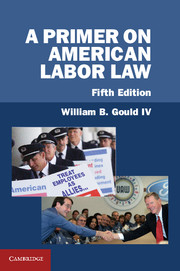Book contents
- Frontmatter
- Contents
- Preface to the Fifth Edition
- Preface to the Fourth Edition
- Preface to the Third Edition
- Preface to the Second Edition
- Preface to the First Edition
- 1 An Overview
- 2 Industrial Relations and Labor Law before Modern Legislation
- 3 The National Labor Relations Act and Related Labor Law
- 4 Unfair Labor Practices
- 5 Establishing the Collective Bargaining Relationship: Organization and Recognition
- 6 Economic Pressure and Bargaining Tactics in the Established Relationship
- 7 Remedies, the Labor Reform Bill of 1978, and the Employee Free Choice Bill of 2009
- 8 Dispute Resolution in the Established Relationship
- 9 The Duty of Fair Representation
- 10 The Public Sector
- 11 Public-Interest Labor Law
- 12 Conclusion
- Index
- References
7 - Remedies, the Labor Reform Bill of 1978, and the Employee Free Choice Bill of 2009
Published online by Cambridge University Press: 05 June 2013
- Frontmatter
- Contents
- Preface to the Fifth Edition
- Preface to the Fourth Edition
- Preface to the Third Edition
- Preface to the Second Edition
- Preface to the First Edition
- 1 An Overview
- 2 Industrial Relations and Labor Law before Modern Legislation
- 3 The National Labor Relations Act and Related Labor Law
- 4 Unfair Labor Practices
- 5 Establishing the Collective Bargaining Relationship: Organization and Recognition
- 6 Economic Pressure and Bargaining Tactics in the Established Relationship
- 7 Remedies, the Labor Reform Bill of 1978, and the Employee Free Choice Bill of 2009
- 8 Dispute Resolution in the Established Relationship
- 9 The Duty of Fair Representation
- 10 The Public Sector
- 11 Public-Interest Labor Law
- 12 Conclusion
- Index
- References
Summary
The principal reasons for the considerable focus on remedies and the emergence of proposals for labor law reform in the Labor Reform Bill of 1978 were the increased caseload of the National Labor Relations Board and the strain that caseload has placed on an administrative statutory scheme that was already convoluted and tortuous. Along with the sharp decline of organized labor in its capacity as a representative for collective bargaining in the workforce, this theme played out again in 2008 and 2009 when the so-called Employee Free Choice Bill was debated.
The problems addressed by both the 1978 and 2008–2009 legislative reforms are long-standing. As Chairman John Fanning of the NLRB said in testimony before the House Committee on Education and Labor:
In 1957, when I was first appointed to the Board, the agency processed a total of 16,000 cases and the Board issued 353 decisions in contested unfair labor practice cases. In the current fiscal year (1972) we will receive more than 52,000 cases and we expect to issue 1,121 such decisions. In fiscal year 1978 we estimate that 57,000 cases will be filed with the agency and we expect to issue 1,242 decisions. In fiscal year 1979 the number of cases will amount to 61,000, and our published decisions will number 1,400.
- Type
- Chapter
- Information
- A Primer on American Labor Law , pp. 229 - 250Publisher: Cambridge University PressPrint publication year: 2013



